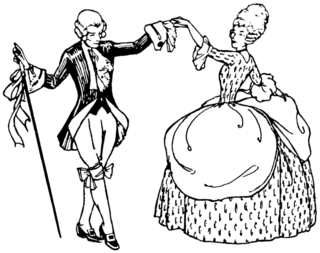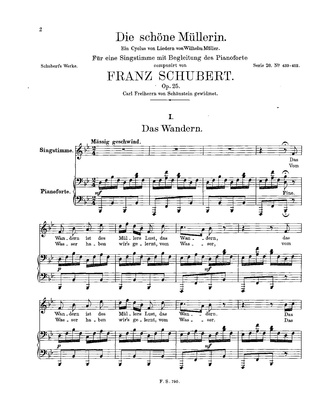Sources
- 1 2 Nettl, Bruno (1956). Music in Primitive Culture, [ page needed ]. Harvard University Press.
- ↑ Giddins, Gary (2004). Weather Bird: Jazz at the Dawn of Its Second Century, p.468. ISBN 9780195348163.
Incomplete repetition is a musical form featuring two large sections, the second being a partial or incomplete re-presentation or repetition of the first. [1]
This form is used throughout the traditional Plains-Pueblo Native American music where the first section uses vocables and the second uses meaningful words or lyrics. Typical formal schemes include ABC, BC, AABC, and ABC and each section uses a tile type melodic contour. [1]
Examples of AABC form include Tadd Dameron's "Lady Bird". [2]

A minuet is a social dance of French origin for two people, usually written in 3
4 time but always played as if in 6
8 to reflect the step pattern of the dance. The English word was adapted from the Italian minuetto and the French menuet.
Ternary form, sometimes called song form, is a three-part musical form consisting of an opening section (A), a following section (B) and then a repetition of the first section (A). It is usually schematized as A–B–A. Prominent examples include the da capo aria "The trumpet shall sound" from Handel's Messiah, Chopin's Prelude in D-Flat Major "Raindrop", and the opening chorus of Bach's St John Passion.
In music, an ostinato is a motif or phrase that persistently repeats in the same musical voice, frequently in the same pitch. Well-known ostinato-based pieces include classical compositions such as Ravel's Boléro and the Carol of the Bells, and popular songs such as John Lennon’s “Mind Games”(1973), Donna Summer and Giorgio Moroder's "I Feel Love" (1977), Henry Mancini's theme from Peter Gunn (1959), The Who's "Baba O'Riley" (1971), The Verve's "Bitter Sweet Symphony" (1997), and Flo Rida's "Low" (2007).
The ballade is a form of medieval and Renaissance French poetry as well as the corresponding musical chanson form. It was one of the three formes fixes and one of the verse forms in France most commonly set to music between the late 13th and the 15th centuries.

A refrain is the line or lines that are repeated in music or in poetry—the "chorus" of a song. Poetic fixed forms that feature refrains include the villanelle, the virelay, and the sestina.
In music, form refers to the structure of a musical composition or performance. In his book, Worlds of Music, Jeff Todd Titon suggests that a number of organizational elements may determine the formal structure of a piece of music, such as "the arrangement of musical units of rhythm, melody, and/or harmony that show repetition or variation, the arrangement of the instruments, or the way a symphonic piece is orchestrated", among other factors. It is, "the ways in which a composition is shaped to create a meaningful musical experience for the listener."
"Form refers to the largest shape of the composition. Form in music is the result of the interaction of the four structural elements described above [sound, harmony, melody, rhythm]."
In the theory of musical form, through-composed music is a continuous, non-sectional, and non-repetitive piece of music. The term is typically used to describe songs, but can also apply to instrumental music.

Strophic form – also called verse-repeating form, chorus form, AAA song form, or one-part song form – is a song structure in which all verses or stanzas of the text are sung to the same music. Contrasting song forms include through-composed, with new music written for every stanza, and ternary form, with a contrasting central section.
Minimal music is a form of art music or other compositional practice that employs limited or minimal musical materials. Prominent features of minimalist music include repetitive patterns or pulses, steady drones, consonant harmony, and reiteration of musical phrases or smaller units. It may include features such as phase shifting, resulting in what is termed phase music, or process techniques that follow strict rules, usually described as process music. The approach is marked by a non-narrative, non-teleological, and non-representational approach, and calls attention to the activity of listening by focusing on the internal processes of the music.
Blackfoot music is the music of the Blackfoot people. Singing predominates and was accompanied only by percussion.
Song structure is the arrangement of a song, and is a part of the songwriting process. It is typically sectional, which uses repeating forms in songs. Common piece-level musical forms for vocal music include bar form, 32-bar form, verse–chorus form, ternary form, strophic form, and the 12-bar blues. Popular music songs traditionally use the same music for each verse or stanza of lyrics. Pop and traditional forms can be used even with songs that have structural differences in melodies. The most common format in modern popular music is introduction (intro), verse, pre-chorus, chorus, verse, pre-chorus, chorus, bridge, and chorus, with an optional outro. In rock music styles, notably heavy metal music, there is usually one or more guitar solos in the song, often found after the middle chorus part. In pop music, there may be a guitar solo, or a solo performed with another instrument such as a synthesizer or a saxophone.
Sioux music prominently features the human voice, with songs accompanied by drumming.
AABC may refer to:

Repetition is important in music, where sounds or sequences are often repeated. It may be called restatement, such as the restatement of a theme. While it plays a role in all music, with noise and musical tones lying along a spectrum from irregular to periodic sounds, it is especially prominent in specific styles.

The Australian Army Band Corps (AABC) is the Australian Army's musical branch. It is roughly the equivalent of the Music Branch and the Royal Corps of Army Music of the British Army. The Corps was formed on 2 August 1968 and provides the Army with musical support and seeks to improve the Army's public image. It consists of 11 individual bands; five full-time and six part-time which are located in the capital city of each state as well as the regional cities of Wagga Wagga, Townsville, and Newcastle.

The Piano Quartet No. 1 in G minor, Op. 25, was composed by Johannes Brahms between 1856 and 1861. It was premiered in 1861 in Hamburg, with Clara Schumann at the piano. It was also played in Vienna on 16 November 1862, with Brahms himself at the piano supported by members of the Hellmesberger Quartet. Like most piano quartets, it is scored for piano, violin, viola, and cello.
The American Amateur Baseball Congress (AABC) is an amateur baseball organization in the United States for players from sub-teens through adults. Founded in 1935, it coordinates its programs with USA Baseball and the American Baseball Coaches Association. AABC has eight (8) age-range divisions in the U.S., Puerto Rico, and Canada. There are also five (5) single-age divisions: 9's, 11's, 13's, 15's, and 17's. In some leagues, however, all divisions are age-range and none are single-age.
"Lady Bird" is a sixteen-bar jazz standard by Tadd Dameron. This "celebrated" composition, "one of the most performed in modern jazz", was written around 1939, and released in 1948. Featuring, "a suave, mellow theme," it is the origin of the Tadd Dameron turnaround (in C: CM7 E♭7 A♭M7 D♭7 CM7).
Navajo is a "verb-heavy" language – it has a great preponderance of verbs but relatively few nouns. In addition to verbs and nouns, Navajo has other elements such as pronouns, clitics of various functions, demonstratives, numerals, postpositions, adverbs, and conjunctions, among others. Harry Hoijer grouped all of the above into a word-class he called particles. Navajo has no words that would correspond to adjectives in English grammar: verbs provide the adjectival functionality.
String Quartet No. 4 in C minor, Stiles 1.2.3.3 SQ4, was completed by Alfred Hill on 25 July 1916 in Neutral Bay, Sydney. It is dedicated to Henri Verbrugghen and his Verbrugghen String Quartet. It is Hill's first non-program string quartet. The first two movements were transcribed for orchestra in 1955 forming the basis of the Symphony No. 4 "The Pursuit of Happiness" in which this music turns to have a program.